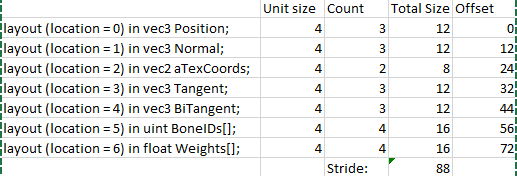Hi all!
I have an strange issue, while migrating my code from OpenGL3.3 to DSA buffers, which i think is related to data alignment in the shaders.
Let me summarize:
I have the following VS (fragment is not really relevant as of now), its a simple shader that draws an animated 3D model with Bones data.
#version 330 core
#define BONES_PER_VERTEX 4
#define BONES_SUPPORT
layout (location = 0) in vec3 Position;
layout (location = 1) in vec3 Normal;
layout (location = 2) in vec2 aTexCoords;
layout (location = 3) in vec3 Tangent;
layout (location = 4) in vec3 BiTangent;
layout (location = 5) in uint BoneIDs[];
layout (location = 6) in float Weights[];
const int MAX_BONES = 100;
uniform mat4 gBones[MAX_BONES];
uniform mat4 model;
uniform mat4 view;
uniform mat4 projection;
out vec2 TexCoords;
void main()
{
TexCoords = aTexCoords;
vec4 Pos = vec4(Position, 1.0);
#ifdef BONES_SUPPORT
mat4 BoneTransform = gBones[BoneIDs[0]] * Weights[0];
BoneTransform += gBones[BoneIDs[1]] * Weights[1];
BoneTransform += gBones[BoneIDs[2]] * Weights[2];
BoneTransform += gBones[BoneIDs[3]] * Weights[3];
Pos = BoneTransform * Pos;
#endif
gl_Position = projection * view * model * Pos;
}
The data source comes from this data structure:
#define NUM_BONES_PER_VERTEX 4 // Number of Bones per Vertex
struct VertexBoneData
{
GLuint IDs[NUM_BONES_PER_VERTEX];
GLfloat Weights[NUM_BONES_PER_VERTEX];
VertexBoneData() { Reset(); }
void Reset()
{
for (unsigned int i = 0; i < NUM_BONES_PER_VERTEX; ++i)
{
IDs[i] = 0;
Weights[i] = 0;
}
}
void AddBoneData(unsigned int BoneID, float Weight);
};
struct Vertex {
glm::vec3 Position = { 0.0f, 0.0f, 0.0f };
glm::vec3 Normal = { 0.0f, 0.0f, 0.0f };
glm::vec2 TexCoords = { 0.0f, 0.0f };
glm::vec3 Tangent = { 0.0f, 0.0f, 0.0f };
glm::vec3 Bitangent = { 0.0f, 0.0f, 0.0f };
VertexBoneData Bone;
};
And, the “old” OpenGL code (opengl 3.X), used to work fine, with this buffer creation:
// Create VAO
glGenVertexArrays(1, &m_VAO);
glBindVertexArray(m_VAO);
// Load data into vertex buffers
glGenBuffers(1, &m_vertexBuffer);
glBindBuffer(GL_ARRAY_BUFFER, m_vertexBuffer);
glBufferData(GL_ARRAY_BUFFER, m_vertices.size() * sizeof(Vertex), &m_vertices[0], GL_STATIC_DRAW);
// Load data into index buffers (element buffer)
glGenBuffers(1, &m_indicesBuffer);
glBindBuffer(GL_ELEMENT_ARRAY_BUFFER, m_indicesBuffer);
glBufferData(GL_ELEMENT_ARRAY_BUFFER, m_indices.size() * sizeof(unsigned int), &m_indices[0], GL_STATIC_DRAW);
// Set the vertex attribute pointers
// vertex Positions
glEnableVertexAttribArray(POSITION_LOCATION);
glVertexAttribPointer(POSITION_LOCATION, 3, GL_FLOAT, GL_FALSE, sizeof(Vertex), (void*)0);
// vertex normals
glEnableVertexAttribArray(NORMAL_LOCATION);
glVertexAttribPointer(NORMAL_LOCATION, 3, GL_FLOAT, GL_FALSE, sizeof(Vertex), (void*)offsetof(Vertex, Normal));
// vertex texture coords
glEnableVertexAttribArray(TEX_COORD_LOCATION);
glVertexAttribPointer(TEX_COORD_LOCATION, 2, GL_FLOAT, GL_FALSE, sizeof(Vertex), (void*)offsetof(Vertex, TexCoords));
// vertex tangent
glEnableVertexAttribArray(TANGENT_LOCATION);
glVertexAttribPointer(TANGENT_LOCATION, 3, GL_FLOAT, GL_FALSE, sizeof(Vertex), (void*)offsetof(Vertex, Tangent));
// vertex bitangent
glEnableVertexAttribArray(BITANGENT_LOCATION);
glVertexAttribPointer(BITANGENT_LOCATION, 3, GL_FLOAT, GL_FALSE, sizeof(Vertex), (void*)offsetof(Vertex, Bitangent));
// Bone Vertex ID's as Unsigned INT
glEnableVertexAttribArray(BONE_ID_LOCATION);
glVertexAttribIPointer(BONE_ID_LOCATION, 4, GL_UNSIGNED_INT, sizeof(Vertex), (void*)(offsetof(Vertex, Bone) + offsetof(VertexBoneData, IDs)));
// Bone Vertex Weights
glEnableVertexAttribArray(BONE_WEIGHT_LOCATION);
glVertexAttribPointer(BONE_WEIGHT_LOCATION, 4, GL_FLOAT, GL_FALSE, sizeof(Vertex), (void*)(offsetof(Vertex, Bone) + offsetof(VertexBoneData, Weights)));
glBindVertexArray(0);
But now I have migrated the code above to OpenGL 4.5 with DSA, and some of the data is not properly passed to the shader. As far as I have seen the “BoneID’s” and “Weights” locations are not properly received in the shader, and I think it might be due to data packing.
The new buffer creation code is encapuslated in a Class that looks like:
#include "main.h"
#include "VertexArray.h"
static GLenum ShaderDataTypeToOpenGLBaseType(ShaderDataType type)
{
switch (type)
{
case ShaderDataType::Float: return GL_FLOAT;
case ShaderDataType::Float2: return GL_FLOAT;
case ShaderDataType::Float3: return GL_FLOAT;
case ShaderDataType::Float4: return GL_FLOAT;
case ShaderDataType::Int: return GL_INT;
case ShaderDataType::Int2: return GL_INT;
case ShaderDataType::Int3: return GL_INT;
case ShaderDataType::Int4: return GL_INT;
case ShaderDataType::Bool: return GL_BOOL;
}
Logger::error("Unknown ShaderDataType");
return 0;
}
VertexArray::VertexArray()
:
m_IndexBuffer(nullptr)
{
glCreateVertexArrays(1, &m_RendererID);
}
VertexArray::~VertexArray()
{
if (m_RendererID!=0)
glDeleteVertexArrays(1, &m_RendererID);
}
void VertexArray::Bind() const
{
glBindVertexArray(m_RendererID);
}
void VertexArray::Unbind() const
{
glBindVertexArray(0);
}
void VertexArray::AddVertexBuffer(VertexBuffer* vertexBuffer)
{
const auto& layout = vertexBuffer->GetLayout();
glVertexArrayVertexBuffer(m_RendererID, 0, vertexBuffer->GetBufferID(), 0, layout.GetStride());
for (const auto& element : layout)
{
switch (element.Type)
{
case ShaderDataType::Float:
case ShaderDataType::Float2:
case ShaderDataType::Float3:
case ShaderDataType::Float4:
{
glEnableVertexArrayAttrib(m_RendererID, m_VertexBufferIndex);
glVertexArrayAttribFormat(m_RendererID, m_VertexBufferIndex,
element.GetComponentCount(),
ShaderDataTypeToOpenGLBaseType(element.Type),
element.Normalized ? GL_TRUE : GL_FALSE,
element.Offset);
glVertexArrayAttribBinding(m_RendererID, m_VertexBufferIndex, 0); // remove Binding hardcoded to 0
m_VertexBufferIndex++;
break;
}
case ShaderDataType::Int:
case ShaderDataType::Int2:
case ShaderDataType::Int3:
case ShaderDataType::Int4:
case ShaderDataType::Bool:
{
glEnableVertexArrayAttrib(m_RendererID, m_VertexBufferIndex);
glVertexArrayAttribIFormat(m_RendererID, m_VertexBufferIndex,
element.GetComponentCount(),
ShaderDataTypeToOpenGLBaseType(element.Type),
element.Offset);
glVertexArrayAttribBinding(m_RendererID, m_VertexBufferIndex, 0); // remove Binding hardcoded to 0
m_VertexBufferIndex++;
break;
}
default:
Logger::error("Unknown ShaderDataType");
}
}
m_VertexBuffers.push_back(vertexBuffer);
glBindVertexArray(0);
}
void VertexArray::SetIndexBuffer(IndexBuffer* indexBuffer)
{
glVertexArrayElementBuffer(m_RendererID, indexBuffer->GetBufferID());
m_IndexBuffer = indexBuffer;
}
And the .h:
#include <memory>
#include "core/renderer/Buffer.h"
class VertexArray
{
public:
VertexArray();
virtual ~VertexArray();
virtual void Bind() const;
virtual void Unbind() const;
virtual void AddVertexBuffer(VertexBuffer* vertexBuffer);
virtual void SetIndexBuffer(IndexBuffer* indexBuffer);
virtual const std::vector<VertexBuffer*>& GetVertexBuffers() const { return m_VertexBuffers; }
virtual const IndexBuffer* GetIndexBuffer() const { return m_IndexBuffer; }
private:
uint32_t m_RendererID; // Our "VAO"
uint32_t m_VertexBufferIndex = 0;
std::vector<VertexBuffer*> m_VertexBuffers;
IndexBuffer* m_IndexBuffer;
};
And the VAO setup is done as follows:
// Allocate Vertex Array
m_VertexArray = new VertexArray();
// Create & Load the Vertex Buffer
VertexBuffer *vertexBuffer = new VertexBuffer(&m_vertices[0], static_cast<uint32_t>(m_vertices.size() * sizeof(Vertex)));
vertexBuffer->SetLayout({
{ ShaderDataType::Float3, "aPos"},
{ ShaderDataType::Float3, "aNormal"},
{ ShaderDataType::Float2, "aTexCoords"},
{ ShaderDataType::Float3, "aTangent"},
{ ShaderDataType::Float3, "aBiTangent"},
{ ShaderDataType::Int4, "aBoneID"},
{ ShaderDataType::Float4, "aBoneWeight"}
});
m_VertexArray->AddVertexBuffer(vertexBuffer);
// Create & Load the Index Buffer
IndexBuffer* indexBuffer = new IndexBuffer(&m_indices[0], static_cast<uint32_t>(m_indices.size()));
m_VertexArray->SetIndexBuffer(indexBuffer);
m_VertexArray->Unbind();
The Stride and offsets that I get are the following:

I think that maybe the Stride is wrong…, bit I don’t know how to calculate it properly… any clue?
Another important point to highlight is that in the “old” code I use to initialize the buffers as follows:
glBindBuffer(GL_ARRAY_BUFFER, m_RendererID);
glBufferData(GL_ARRAY_BUFFER, size, data, GL_STATIC_DRAW);
But in the new code, I’m using the DSA functions, like:
glNamedBufferStorage(m_RendererID, size, data, GL_MAP_READ_BIT);
Does it may have any impact?
Thanks in advance!!!
